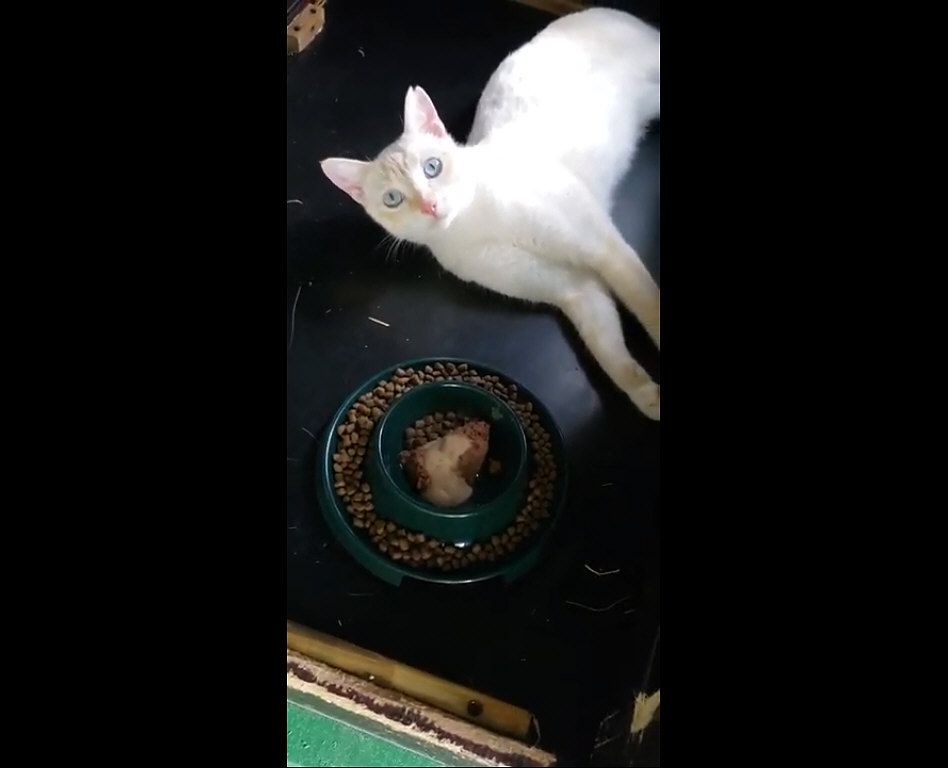A Free-Roaming Cat Family and Me (Part 5)

My cat family lived contentedly outside. The only times we touched were when Mama Kitty cautiously rubbed her furry back against my leg. She trusted me to feed her and her offspring, now longer than she is, but not nearly so rolly polly. I guess she ate as often as she could get me to feed her because nearly starving in her childhood turned her into an always-anxious-for-the-next-meal kinda kitty. As soon as I walked outside through the kitchen door, she would rub her soft furry self against my legs repeatedly. She got underfoot, almost tripping me when I walked along the outdoor sidewalk to place her and her kids’ bowls of wet and dry food on the patio.
Most people trying to domesticate free-roaming cats have a rough go of it. My friend Rhonda had two kittens, both rescued, one sweet, docile and rarely upset, and the other, Pixie, sweet and purring then suddenly angry and scratching. “These were my children’s indoor/outdoor pets,” Rhonda says. “They said Pixie had ‘mood swings’.” Sometimes other children, who came by to play, tried to rest their heads on Pixie’s pillow, and ended up getting scratched or bitten.
Trying to domesticate a free-roaming cat or kitten is a long, hard, time-consuming task which doesn’t always work. Rhonda struggled trying to get half-feral Pixie into a carrier to take her to the vet for shots once a year. Then it took the vet and an assistant to hold her down. The vet said Pixie would never be completely domesticated.
Numerous challenges arose. Pigeons discovered the cats’ food and, the moment the cats stepped away, swooped in to gorge on it. Soon dozens of pigeons as fat as chickens started regularly scaring the cats away until the birds got too bold and the cats made feathers fly. I started putting the cats’ food inside humane traps, which sometimes worked to keep pigeons away. However, at night, when I checked on the cats on the patio, I would often find a bullfrog eating the cats’ food and soaking in their water. So I’d grab the frog with gloves, run about a block away, and throw it in someone else’s yard. That solved the problem until the next frog arrived.
I was fortunate to have compassionate, understanding neighbors who worked with me to manage problems caused by the cats eating plants and birds in their yards. I researched and discovered that cats like to eat several small meals because they can’t eat a whole lot at any one time. I started feeding them more often so they’d hunt less frequently. My neighbor Gary said that helped. I also sprayed cat repellent around the edges of his yard.
Gary’s feelings toward our cats changed the day he let me use his studio to tape a Facebook Live talk about my book Angel Hero, Murder in Hawaii, A True Story. Little Mama, wanting to guard me, I think, followed me across the street to his studio. She didn’t run away even when Gary appeared. Gary, a soulful guy, saw the bond that little cat carried for me, and helped me hang CDs from the clothesline to chase away the pigeons stealing her food.
The cats also liked to jump on and play in our next door neighbor Jenny’s many plants. She went so far as to build little greenhouses around the plants so the cats couldn’t play in them.
I worried about how I could trap our outdoor cats if something happened to them. Thankfully, our three female cats (there used to be four, but our biggest white kitty ate rat poison some neighbor left out) were living healthy lives outdoors. Fleas were the biggest issue. The cats were scratching. I tried to figure out how to keep fleas off them, but I couldn’t apply Frontline or other chemical flea treatments to the backs of their necks because they wouldn’t let me touch them there. A woman on the Cat People of Oahu Facebook page gave me an idea, though. She tied a flea treatment package to a stick and sprinkled flea powder on the cat’s neck. Probably not as effective as rubbing it in, but better than nothing.
I planned to follow in her footsteps and sprinkle my three girls with flea medicine, but in July, 2019, the cats’ world and ours turned topsy turvy. Lily passed, and Barry and I had to move out suddenly because the trustees said they wanted to ready the house for sale. We got lucky, quickly finding a rental with a yard so I could have an enclosure built for the cats, who would have run away if they hadn’t been enclosed for several months to get used to the new place. With the move, a whole new set of cat challenges and delights arose. But that, as they say, is another story.
Read More:
Part 1
Part 2
Part 3
Part 4
Part 5

Lizbeth Hartz is the author of the true crime, true love memoir Angel Hero, Murder in Hawaii, A True Story. Buy it on Amazon or sign up to read the 1st chapter free.